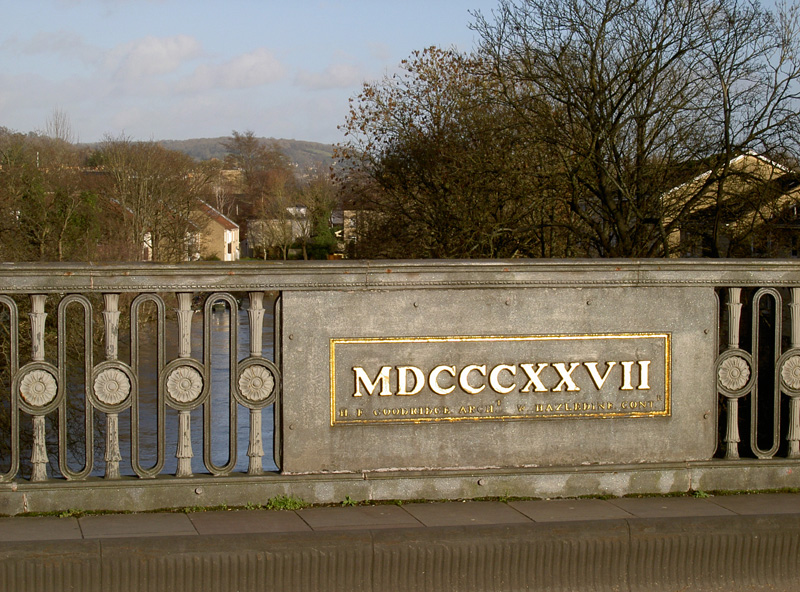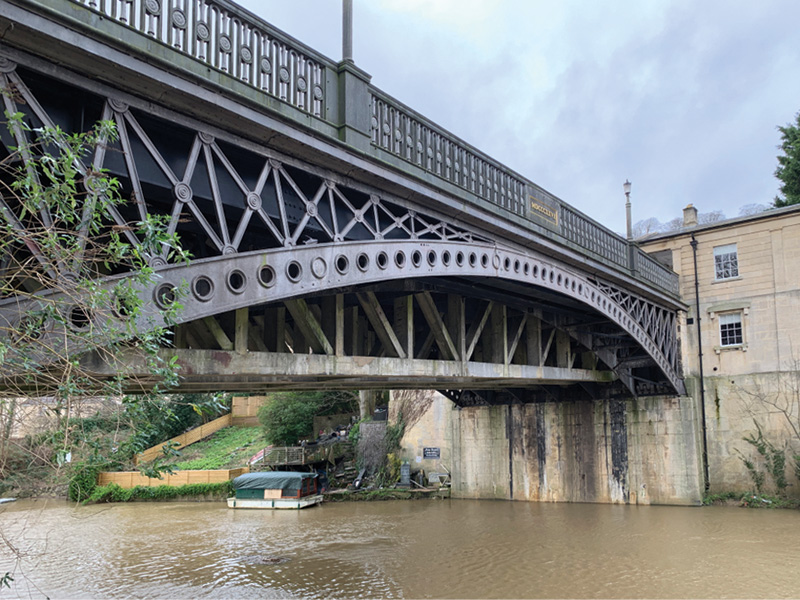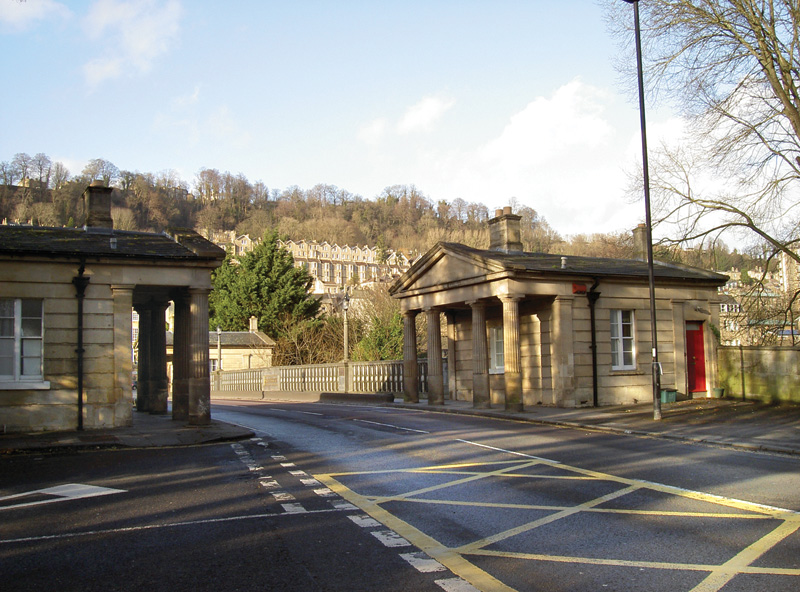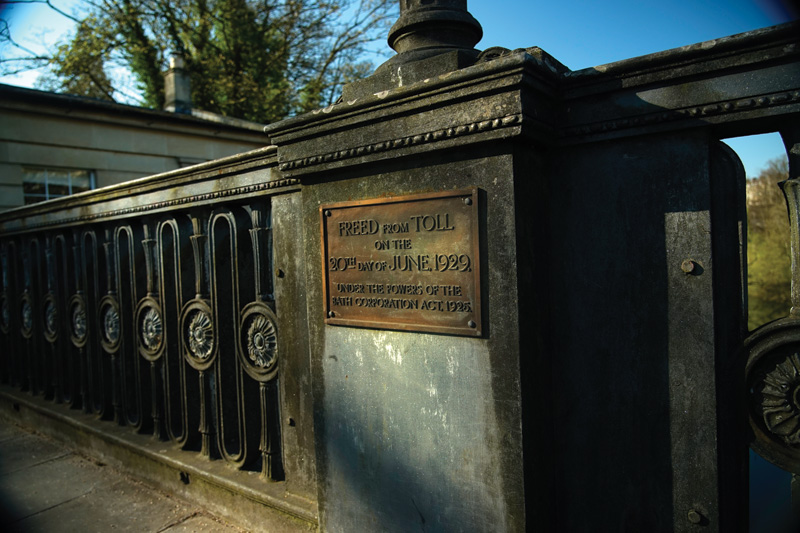Cleveland Bridge, spanning the River Avon at Bathwick, was built as a toll bridge in 1826 on the site of a Roman ferry crossing, designed by Henry Goodridge to take the traffic of his day, horse-drawn vehicles and pedestrians. Now weakened by decades of heavy traffic, refurbishment works are starting to strengthen the bridge. But will this protect the elegant Grade II listed bridge from the heavy traffic that uses it? Or is the bridge’s position on a Primary Network road being considered above the need to protect it? Here we look at the history, the debate and hear some local perspectives.
Many of Bath’s traffic problems are caused by one simple fact – the old city was built in a huge bend in the River Avon, encircling the city on three sides. Although this necessitated several river crossings, most were either fords or ferries. For centuries, the only bridge was the Old Bridge on the south side. It was not until the early 18th century that Newton Bridge gave access from the south west to the north side of Bath. Even the addition of Pulteney Bridge in 1776 did not help, since it led only to Bathwick. Had William Johnstone Pulteney achieved his plans for what was known boldly as Bath New Town, the issues we face now with Cleveland Bridge would not exist.
The Pulteney estate was intended as a grand entrance to the city, with Sydney Gardens at its heart, between Upper Great Pulteney Street and Great Pulteney Street. The planned route involved making a new turnpike road from Pulteney Bridge through Bathwick and Bathampton, to cross the river at Bathford. Almost immediately there were objections. Petitions – including one from the turnpikes commissioners who saw their income from road tolls about to disappear – were presented to the House of Commons, opposing the idea. They were successful. The route was refused. Travellers wishing to reach Bathwick from the north either had to go through the city or take the ferry, which crossed from what today is Bath Canoe Club’s jetty to the garden of Riparian House.

However, in 1789 it was announced that “for the convenience of the Upper Town, a large and commodious ferry (lately launched) is kept opposite Walcot Parade.” So the usual ferry was not adequate for the crowds who flocked to the gardens. Yet it would be almost another 40 years before the bridge would be built, by which time Villa Gardens had long vanished under more building in Bathwick Street. These new developments made the construction of a bridge even more imperative.
The landowner, the Earl of Darlington, was elevated to Marquis of Darlington in 1827, so negotiating to have this bridge built and opened that year may well have been by way of celebration – it certainly opened up the estate to more traffic, and while it was not the grand entrance to the city that Pulteney had envisaged, it meant elegant traffic could avoid Walcot Street, with its shops and industries. The position of Cleveland Bridge had been suggested by Pulteney as early as 1805.
Although Pulteney could not have known it, Roman finds began to be found in Bathwick. As work commenced on the bridge in the 1820s, more Roman remains turned up, and archaeologists now believe the site was that of the first bridge into the city, built by the Romans. At the very least, a Roman crossing lay just to the south of the site. The bridge’s architect Henry Edmund Goodridge was possibly influenced by these finds, designing severely classical toll-houses, in the then fashionable Greek Revival style. He also decided to use the latest in bridge technology – a cast iron single arch. The resulting structure was one of great beauty – light yet strong, classical but modern.
By the 20th century the bridge was seen as outdated. Firstly, it was a toll bridge, and secondly, it was not strong enough for motorised traffic. In 1929, it was strengthened by adding concrete reinforcements between the cast iron arches, and the tolls removed.
Bath has a habit of ‘modernising’ structures in the name of progress and later finding out this was not such a good idea. If Brunel’s beautiful bridge over Pulteney Road had not been replaced in the 1970s with a hideous girder bridge, heavy lorries would not be able to go through Bathwick. If Cleveland Bridge had not been strengthened, only light traffic would be able to use it. Had William Pulteney been able to take his first route, none of this would have been necessary, nor would all the agonising over a link road across the Avon Valley.
The refurbishment of the bridge – statement from B&NES:
“Although the bridge is almost 200 years old, and was originally built for pedestrians and horse-drawn carriages, it now carries around 17,000 vehicles a day, including coaches and heavy goods lorries weighing up to 44 tonnes. It forms part of the A36, a major strategic highway to the south coast. Without this river crossing, traffic would either need to route through the historic centre of Bath, along ancient streets which are protected by access and weight restrictions, or divert using roads to the east, costing motorists considerable time and fuel costs. From a heritage perspective, the bridge is a Grade II-listed structure that we have a legal duty to preserve appropriately.
“Surveys have identified that *structural components of the bridge need to be maintained, repaired or replaced for it to continue to function safely. **The proposed refurbishment works would ensure the structural safety and integrity of the bridge, and would also preserve the heritage value of this listed structure.
“These extensive repairs will be assisted by a grant from the Highways Maintenance Challenge Fund… This additional support means that we will be able to carry out this major renovation project, without a dramatic effect on our funds available for more routine road maintenance throughout our region.”
The work taking place at Cleveland Bridge:
• Repairs to the deck slabs (the foundation of the flat top of the carriageway)
• Repairs to the masonry abutments (stone supports)
• The thickening of the Warren reinforced concrete trusses by 50mm ***
• Repairs and repainting of the cast iron arches and parapets
• Waterproofing to prevent future weather damage
Observations on B&NES’ statement
“Structural components of the bridge need to be maintained, repaired or replaced” – the plans approved cite the need for ‘strengthening’. This is a sore point, and key to arguments against the works.
** “The proposed refurbishment works would ensure the structural safety and integrity of the bridge” – this statement is misleading in that it omits the phrase ‘increased load-carrying capability’.
Observations on the refurb work:
*** The visual impact of thickening the concrete trusses will detract further from the curve of the beautiful arch.
The way forward for the bridge, by The Bath Magazine
Refurbishment works, described as ‘essential repairs’, will soon be starting on Cleveland Bridge, funded by a £3.56 million grant from the Department of Transport, with the remaining £360,000 provided by B&NES. The work is being carried out by construction company Dyer and Butler.
There is, however, considerable controversy about the planned works. Because of the bridge’s listed status, work can only repair and strengthen the deck and the concrete structure to operate for the situation at the time of its listing, circa 1950. A temporary weight restriction was put in place in February 2020, affecting heavy goods vehicles and larger coaches. This was organised ahead of the essential structural repairs as a precautionary measure, because surveys have shown that some structural parts of the bridge have come to the end of their life.
The weight restriction of 18 tonnes, limited to 18 months, is due to revert back, not to 44 tonnes as it was previously, but to the new national limit of 48 tonnes in August this year, once the work is done. So put plainly, the plan is to strengthen the bridge and then allow heavy vehicles to continue crossing it. The motivation for this is clearly to keep the traffic flowing, and not to protect the listed bridge.

Not everyone is in agreement with this strategy. Wera Hobhouse, the Liberal Democrat MP for Bath, in October last year brought a motion to Parliament asking for them to agree to a permanent weight restriction on the bridge (see overleaf), further to representations from her ward. This motion was responded to by the Parliamentary Undersecretary Rachel Maclean, who said that “decisions about how Bath is best linked to the major destinations are for the relevant local Highway Authority to make.” She implied that the onus is on Wera Hobhouse and the Council’s Local Highway Authority to follow the DfT’s Guidelines by negotiating with neighbouring authorities. So there is provision for the alteration of this Primary Route, but negotiation is needed. So what are the barriers to this being done?
The critical issue in the debate – and the one that has always dominated the conversation about the bridge – is that it is on a route that is part of the Primary Route network. Other local authorities, such as Wiltshire Council and Dorset Council, and the Highways Agency, who would need to agree to any weight restriction or other structural solutions, have taken the view that you can’t impose a permanent weight restriction on a Primary Route. But their stance is clearly to do with the transport system, not about protecting the bridge.
Overleaf, we hear from Bath’s MP Wera Hobhouse and other locals.
The Cleveland Bridge permanent weight restriction debate in Parliament on 17 November 2020: Excerpts from Hansard
Wera Hobhouse, Liberal Democrat MP for Bath:
“Cleveland Bridge is a grade II listed structure. It forms part of the character of Bath’s UNESCO world heritage status. The protection of the city … is of national importance, and it should not just be the citizens of Bath and the council … called on to safeguard this treasure for future generations.
“Cleveland Bridge links the north and the south of the city over the River Avon just a short walk from the city centre and is surrounded … by listed architecture. Unfortunately, it is part of the Primary Road network and has to be open to all traffic. The bridge consists of 19th-century ironwork with a 1920s concrete deck, but the weight of modern heavy goods vehicles is shaking the bridge to bits. Heavy traffic on the A36 and the alternative A350 has been a source of tension for many residents for many years.
“…The challenge of a listed heritage asset is that you have to work with the structure as it is listed. You cannot replace the Victorian ironwork – because it is listed. You cannot replace the 1920s concrete deck – because it is listed. You can only repair and strengthen them, but they will never be stronger than when they were new, and when they were new, they were never expected to carry the very heavy vehicles that are being used today. The innovation of the bridge’s design, in both the early 19th and 20th centuries, is recognised in its listing, but those designs never envisaged that the bridge would be on a modern Primary Road network, with all that that entails.
“Next year will see the very latest technology deployed to save the 1920s concrete structure. The danger is that bringing back the heaviest lorries will hasten the collapse of the deck, destroying the listed asset forever. With continuing heavy lorries, it is estimated that the current repairs may last for only 15 years. Therefore, without a permanent weight restriction, my concern is that while progress will be slow on an upgrade to the A350, Cleveland Bridge will again be in need of urgent, serious repairs very soon. We cannot let that happen. It is absolutely essential that we set a weight limit that the bridge can sustain for the long term.
“The Department for Transport has expressed its view that the A350, as the major north-south link, is a viable option, and in Bath neither I nor the Council would disagree. However, the Department for Transport has not done enough so far to create a consensus among councils and MPs in the Wiltshire constituencies to take this option forward to its final completion.”
Rachel Maclean, The Parliamentary Under-Secretary of State for Transport
“The West of England Combined Authority considers the repair of Cleveland Bridge … as a priority. It sees Cleveland Bridge as a key structure in its regional network. As the hon. Member rightly said, issues on the structure have resulted in weight and speed restrictions, which the authority considers incur significant associated economic cost. Its view is that further restrictions will have an impact on safety, the economy and air quality, with higher carbon emissions. That is why the authority is very supportive of investment prioritisation for both these schemes.
“Highways England [are] carrying out … a strategic study that will review north-south connections between the M4 and the Dorset coast. That will include a review of the case for adopting the A350 corridor as the main strategic route for the area in place of the A36/A46 via Bath and will consider the case for the trunking or de-trunking of key routes. So I hope I can reassure the hon. Lady that both Highways England and officials in the department will engage with the Western Gateway … [and] with a range of local stakeholders as the study develops. I should add that decisions about how Bath is best linked to the major destinations are for the relevant local Highway Authority to make.”
To read the full Hansard report, search ‘Hansard’ and ‘Cleveland Bridge’ in your internet browser

Voices from the city
Peter Fellows
Lives on Bathwick Street
“I live just metres away from Cleveland Bridge, and am on nodding terms with drivers sitting in traffic jams in Bathwick Street, when I venture upstairs from my basement flat.
“Surely our beautiful Cleveland Bridge needs saving from heavy traffic with an enforced permanent weight limit. The council received funding of £3.5 million pounds from the government to temporarily renovate the bridge for perhaps 20 years. Once the renovation is completed, the temporary weight restrictions will be lifted, allowing heavy traffic to return; bringing about even more CAZ dosh into the council’s coffers.
“The real answer is to complete the missing link at the Swainswick junction, where the A46 and A36 are in tandem. Perhaps a tunnel should be built beneath Bathampton Meadows to a point on the A36, beyond Bathampton and Limpley Stoke, or build a ‘unique’ suspension bridge instead of a tunnel. The alternative is to transport freight at night by rail! The citizens of Bath cannot be expected to tolerate heavy vehicles using the A4 and A36 through the city streets.
“The current Cleveland Bridge temporary weight restriction has diminished heavy traffic and yet once the bridge is strengthened, I dare say congestion will return…
“How can we protect the bridge? We should ensure there is no-access for heavy vehicles through Bath and across the Cleveland Bridge, which is situated on National Highway, the A36. Sat-navs should never be programmed to indicate the shortest route from the A46 through Bath is along the A4 to the A36 at Cleveland Place; along Bathwick Street to Sydney Gardens and onwards along Warminster Road (left), or Sydney Place and Pulteney Road (right).
“Another thing that upsets me is the transportation of live animals along Bathwick Street in HGVs from the farms to the abattoirs. You can hear them squealing, bleating and lowing and smell the fear as those poor animals travel to their deaths, whilst stuck in a traffic jam on their final journey.”
Roy Carson
Local who has set up a petition for a permanent weight restriction on the bridge
“The withdrawal of any weight limit means the immediate imposition of the new national default of 48 tonnes. Given that the need for these ‘repairs’ was caused by excessively heavy vehicles crossing the bridge, why now subject it to even heavier vehicles?
“A 16-tonne weight limit would, undoubtedly, extend the working life of the bridge, and its elegant proportions (mask out the Warren trusses with your fingers as you look at its beautiful arch).
“Removing the Primary Route (PR) designation from the A36, which crosses the bridge, would rid us of the through-traffic problem at a stroke. The government initiative CAZ will hopefully curb local traffic excesses. However, council initiatives such as Low Traffic Neighbourhoods, Liveable Neighbourhoods, bollarded cycle lanes and eScooters are already causing more problems than they are likely to solve.
“The council and our MP should put all their efforts into removing the PR designation. Everything else is merely rearranging the deckchairs on a Titanic-sized pollution problem, a distraction from the true cause of that problem, a cause they seem unwilling to deal with.
“Protecting the listed bridge and solving Bath’s transport problems are not competing or mutually exclusive aims. By removing the A36’s Primary Route designation, we would see an instant improvement in both. The B&NES Planning Committee’s recent approval for the strengthening of the bridge was a huge mistake for our city. It will inevitably lead to the bridge’s rapid deterioration and, equally important, a rise in pollution, congestion and noise as those 48-tonne HGVs crawl back over it and through our city streets. Not good for our UNESCO city’s heritage architecture, nor for our lungs.”

Peter Hayes
Sculptor who has a studio in one of the lodges
“I came to live in Bath in 1982 after a 10 year stint of working in Lesotho, Swaziland and Botswana. I was looking to set up a studio in Bath and eventually came across the Lodges on Cleveland Bridge. These were beautiful buildings but were in a state of significant disrepair. I approached the council with the suggestion that these lodges would make excellent starter units for artists. After some negotiation I acquired Number 2 and converted it into my working studio.
“As an artist I find working from my studio on the bridge very inspirational, with the river in all its moods and the hustle and bustle of the Cleveland Bridge traffic. This historical landmark has been bruised and battered over the years and is in need of a major facelift. With the recent pandemic and the 18-tonne weight restriction, the bridge took on a serene status and I would love to see a permanent restriction, especially now we have the Clean Air Zone.”
Cllr Dr Yukteshwar Kumar
Liberal Democrat Councillor for Bathwick
“Cleveland Bridge is a Grade II* listed building and, like the Taj Mahal or the Great Wall of China, the residents and the council have a combined duty to protect this. I welcome the news of the refurbishment of the bridge, but we must work to ensure that the humongous HGVs and large lorries do not rape this monument on daily basis – thousands of times day and night.
“We know that the bridge was built by the architect Henry Goodridge for horse-drawn vehicles and pedestrians and four toll houses were erected at all the corners, giving an appearance of small four ancient temples.
We need to protect our ‘temple’ and as soon as refurbishment works are finished in October, the council should find a way to impose heavy tolls for huge HGVs and lorries, so that the monument is protected, and our environment is greener for our posterity.”
Ideas for changing the primary route
David Andrews
Chair of Bath Trams; bathtrams.uk
“I propose a slow bypass/link road connection from the Batheastern bypass to the Warminster Road. Most bypasses are expensive and unnecessarily upgraded compared to the roads they are connected to such as the pointlessly dual carriageway Batheastern bypass which is connected at both ends to single carriageways.
Why not close one full lane of the Bathastern bypass and convert it into a long Park & Ride serviced by a tram?
Also a small single carriageway tunnel under the railways and under the canal would connect to the Warminster Road, permitting car drivers from there also to park in the linear Park & Ride.
It would connect at the Warminster Road by a traffic light system – not the gigantic roundabout that would normally be the case. Thus it is not designed to speed up traffic through Bath but to make it take the same amount of time. Otherwise this would simply generate more traffic.
An alternative would be to have have a a bridge over the river parallel to the existing railway arch at the Batheastern end of the bypass so vehicles accessing the Warminster Road from the bypass would pass under the existing railbridge presently leading to Bradford-on-Avon and Sally in the Wood, double back and cross the river in the new small bridge and run along parallel and close to to the railway on the the Bradford side of the trailway, again using a single carriageway. This could be screened by trees disguising it, and then as it approaches the rail spur to Bradford it tunnels under the trailway and under the canal.
Again the intention is not to speed traffic as this will take the same amount of time as lorries going through Bath simply to get them out again.

Dorian Baker
Transport consultant
“Having spent most of my life working with tunnels, from 1995 I started thinking about how we could address the A36 to A46 problem using some short lengths of tunnel. The roads south of Dry Arch and north of Swainswick are single carriageways so tunnels 11 metres wide with a 9-metre carriageway would work for the 1400m missing link. This link would not need a new river bridge – much of the Batheaston Bypass is on the south side of the river, connected by two new bridges originally intended to carry traffic that is still using Cleveland Bridge.
“From 2008 a Bath Park and Ride East scheme was proposed, to be built on Bathampton Meadows between the newly built bypass and the river. Many of us objected strongly to this idea as it would have completely ruined the meadows.
“The scheme I put forward between 2011 and 2015 was to use the ‘brown’ land of the old Bathampton Station to build a new sub-surface car park linked to the A4 by a short tunnel under the railway and dual carriageway. By building the car park between the main line to London and the branch to Southampton we could also build a new station on the Southampton line for the ride into Bath, which would be four minutes to Southgate.

“About a third of the traffic entering and leaving the city is from origins to the east, along the A4 and the A36. By linking these two roads at the P&R site, traffic from both routes could reach this new P&R station.
“From its junction on to the Batheaston Bypass, the first length of the link road would be in a covered way for about 360 metres under the main line railway, through the car park, under the Southampton line, then beginning to rise at a gradient of 1 in 20. Continuing at 1 in 20, the next 480m would be at about existing ground level, then a 250 metre ‘cut and cover’ tunnel to Dry Arch corner, at a low level. South of this corner the existing road slopes quite steeply so the final length in a 270m ‘driven’ tunnel avoids the 13-metre rise up to Dry Arch before starting to drop down into the valley. Out of 1400m, 880m in tunnel.
“By putting the two transport objectives together and building as much as possible of the new infrastructure below ground level, we could reduce the total environmental impacts of the scheme and remove all north-south through traffic from Cleveland Bridge.
“The coup de grace would then be to get the Department for Transport to remove Cleveland Bridge from the primary road network and empower B&NES to set a permanent weight limit that is as low as we like.”
With many thanks to #BridgeBaddies for permission to use their images
The post Protecting Cleveland Bridge appeared first on The Bath Magazine.